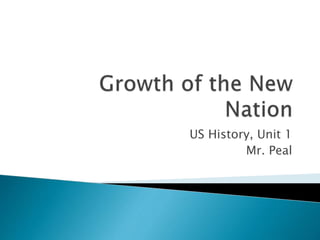
US History Unit 1: Westward Expansion and Population Growth Fuel North-South Conflict
- 1. US History, Unit 1 Mr. Peal
- 2. 1. LAND ◦ The U.S. spread to the Pacific Ocean. 2. WEALTH ◦ Factories, railways, cities… 3. NUMBER OF PEOPLE, including: ◦ Great increase in number of slaves ◦ Great increase in number of immigrants from Europe
- 4. Louisiana Purchase, 1803 Texas, 1845 Oregon, 1846 California, 1848 Gadsden Purchase, 1853
- 5. Bought in 1803 from France Doubled the size of the county Explored by Merriwether Lewis and William Clark ◦ Slow and dangerous trip ◦ Cross the Rocky Mountains ◦ Reached the Pacific
- 6. Indians were “removed” from Georgia because Americans wanted their land when gold discovered there. Congress and President Andrew Jackson made Indians in Georgia and other states live west of the Mississippi. Americans felt superior…thought they had a mission to settle the continent.
- 7. Texas belonged to Spain for 300 years Settled by Americans because of… ◦ Good land for growing cotton ◦ Large amount of land for raising cattle (cowboys!) Before long, there were more Americans than Texans. Conflicts between Mexicans and US settlers: ◦ Mexicans were Catholic, settlers were Protestants ◦ Americans had slaves, Mexicans didn’t like slavery ◦ Difference in language and culture made it difficult for people to get along
- 8. 1836: Mexicans attacked a fort called Alamo and killed all the Americans. 1845-8: War with Mexico to make Texas a state Texas became a state; allowed slavery.
- 9. Oregon territory attracted families because of forests and farmland. Settlers followed the Oregon Trail. Included parts of Canada, Idaho, Wyoming
- 10. John Sutter Where the 49ers got their name. Gold-diggers came from Europe, China, and the east California grew quickly. San Francisco became a city
- 11. NOTICE: Indians. What the figure has in her hand. Types of transportation. The dark.Painting by John Gast
- 12. The Industrial Revolution was a huge change from… 1. farming to factory work 2. living in the countryside to living in cities 3. Skilled hand-work to unskilled machine work
- 13. 1. Began in England and spread to America. 2. Required factory workers, money, and natural resources (coal and iron) 3. Took place in factories with MACHINES that now did the work. 4. Was mostly in the NORTHERN states. The ECONOMY is made up of human activity related to buying, selling, and making goods and services in a country.
- 14. Cotton factories in England and America needed American cotton. Slaves grew cotton. As the need for cotton grew, ◦ The demand for slaves grew ◦ The demand for cotton land increased The number of slaves increased Southern (cotton) states wanted to expand west. The South wanted new states to be slave states.
- 15. America is a huge country, and people got around by foot, horse, and wagon. This was slow and expensive. At first, canals solved the problem ◦ Erie Canal (1825) ◦ Chesapeake and Ohio Canal (opened in 1831, used until 1924) Canals reduced the cost to send food to eastern cities, but there were too expensive to built and too slow
- 16. Railroads moved people and goods quickly and cheaply over long distances (and America was a big country) Invented in England Baltimore and Ohio Railroad (1827) By 1850: 9,000 miles of tracks By 1860: more than 30,000 miles of tracks, enough to encircle the world It now cost less for American farmers to ship food around the world and make $$$
- 17. What railroads did for things and people, the telegraph did for information. Used electricity to send messages over long distances. Invented in 1844 by Samuel Morse. There were 20,000 miles of telegraph wire in 1850 and 50,000 by 1860, enough to circle the earth twice.
- 18. Railroads created a great need for… IRON for tracks and railroad cars COAL to run the locomotives Machines Cotton created a great need for… IRON for machines Machines All that new farm land created a new for… IRON machines New types of machines to take care of large farms
- 19. Total number of people 1790: 4 million people 1860: 31 million people People in Cities 1790: 5% (5 out of 100) 1860: 15% (15 out of 100) Until 1830, there were few immigrants (people who came from other countries) Number of Slaves 1790: 400,000 1860: 4 million
- 20. In the 1840s, millions of people from Ireland came to America because of the destruction of the potato harvest. In the 1850s, Germans came too. After the Gold Rush, many Chinese came to look for gold and work on the railroads.
- 21. Many Americans did not like any foreigners. Many Americans did not like Catholics. Many Americans did not like non-Christians (Jews and the Chinese) Many Americans did not like people with darker skin (Chinese, Native Americans)
- 22. As people moved West, ◦ South wanted to go West to grow more cotton ◦ North wanted to go West to farm and start factories ◦ Indians were killed or pushed west ◦ North and South competed to control new states As population increased ◦ Number of slaves increases, and ◦ People move to America from Ireland and China, and some Americans do not like them Not everyone benefited from changes ◦ Slaves ◦ Women
- 23. NORTH: Built factories and used cotton from the South SOUTH: Grew cotton, with slaves, for North and for England
- 24. Slave or Free??? North or South: Which side should rule the country?
Notes de l'éditeur
- Vocab: steam engine, suffrage, industry, migrate, telegraph, Alamo, Gold Rush, Lewis & Clarke, Slater, population, economy
